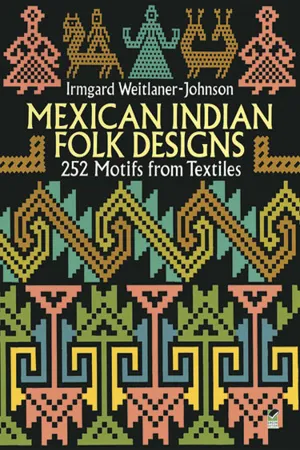
- 96 pages
- English
- ePUB (mobile friendly)
- Available on iOS & Android
About this book
This fascinating book is the product of intensive scholarly research, its exacting illustrations based on choice examples of Mexican Indian textiles in many different museums and private collections. Incorporating abstract and geometric forms as well as highly stylized images of flowers, plants, animals, birds, and humans, the patterns represent more than 20 major Mexican Indian cultures.
Among the designs are a two-faced feathered serpent from the Huichol culture, an allover pattern dominated by horizontal zigzags woven by the Otomí, and a flower and leaf design from the Tepehua. The Huasteco people are represented by a bold motif featuring prancing animals with bushy tails; a Nahuatl design depicts a lion with a flower in his mouth; while an elegant curvilinear Mazatec motif features flowers, vines, and birds. Other peoples whose art is represented include the Tarahumara, Tepecano, Mestizo, Zapotec, Mixteco, and Cuicatec. In the bold, startling designs originated by these cultures are primal links to the imagery of other cultures and traditions, centuries old and worldwide.
Artists, designers, and craftspeople will value this modestly priced collection as a source of striking and unusual royalty-free designs for inspiration and practical use; anyone interested in Mexican Indian culture will find it an important reference as well.
Frequently asked questions
- Essential is ideal for learners and professionals who enjoy exploring a wide range of subjects. Access the Essential Library with 800,000+ trusted titles and best-sellers across business, personal growth, and the humanities. Includes unlimited reading time and Standard Read Aloud voice.
- Complete: Perfect for advanced learners and researchers needing full, unrestricted access. Unlock 1.4M+ books across hundreds of subjects, including academic and specialized titles. The Complete Plan also includes advanced features like Premium Read Aloud and Research Assistant.
Please note we cannot support devices running on iOS 13 and Android 7 or earlier. Learn more about using the app.
Information
Publisher’s Note
Table of contents
- DOVER PICTORIAL ARCHIVE SERIES
- Title Page
- Copyright Page
- Table of Contents
- Publisher’s Note